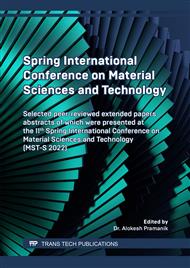[1]
J. Voland RT, Huebner LD, McClinton CR. X-43A Hypersonic Vehicle Technology Development[J]. Acta Astronautica, 2006.59(1-5): 181-191.
DOI: 10.1016/j.actaastro.2006.02.021
Google Scholar
[2]
Krenkel W. Carbon Fiber Reinforced CMC for High-Performance Structures[J], International Journal of Applied Ceramic Technology, 2014, 1(2): 188-200.
DOI: 10.1111/j.1744-7402.2004.tb00169.x
Google Scholar
[3]
H. Böhrk, U. Beyermann. Secure tightening of a CMC fastener for the heat shield of Re-entry vehicles[J]. Compos. Struct.,92(2010): 107-112.
DOI: 10.1016/j.compstruct.2009.07.002
Google Scholar
[4]
Zhang Qiliang, Cao Zengqiang. Study on factors influencing the performance of composite bolted connections[J]. Acta Aeronauticaet Astronautica Sinica, 2012, 33(4): 755-762 (in Chinese).
Google Scholar
[5]
Gray PJ, MaCarthy CT. An Analytical Model for the Prediction of Through-thickness Stiffness in Tension-loaded Composite Bolted Joints[J], Composite Structures, 2012, 94(8): 2450-2459.
DOI: 10.1016/j.compstruct.2012.02.011
Google Scholar
[6]
Z. Huda, P. Edi. Materials selection in design of structures and engines of supersonic aircrafts: a review[J]. Mater. Des., 46(2014): 552-560.
DOI: 10.1016/j.matdes.2012.10.001
Google Scholar
[7]
Zhang Q, Li G. A Review of the Application of C/SiC Composite in Thermal Protection System[J]. Multidiscipline Modeling in Materials and Structures, 2009.5(2): 199-203.
DOI: 10.1163/157361109787959903
Google Scholar
[8]
Zhao Libin, Xu Jifeng. Analytical Method for Connecting Structure of Advanced Composite Materials [M]. Beijing: Beihang University Press, 2015(in Chinese).
Google Scholar
[9]
Wulz H G. Joining fastening and sealing of hot CMC structures[C]// 33rd Thermophysics Conference, Norfolk, VA, USA: AIAA, 1999: 35-52.
DOI: 10.2514/6.1999-3552
Google Scholar
[10]
J.L. Narottam, P. Bansal. Ceramic Matrix Composites: Materials, Modeling and Technology[M]. Canada: John Wiley & Sons, Inc., (2017).
Google Scholar
[11]
Zhang Y F, Zhou Z G, Tan Z Y. Experimental and finite element research on the failure mechanism of C/C composite joint structures under out-of-plane loading[J], Materials, 2019, 12(18): 1-16.
DOI: 10.3390/ma12182922
Google Scholar
[12]
Li G, WuX, Zhang C, et al. Theoretical simulation and experimental verification of C/SiC joints with pins or bolts[J], Materials and Design,2014, 53(1): 1071-1076.
DOI: 10.1016/j.matdes.2013.08.001
Google Scholar
[13]
Li G, Zhang Y, Zhang C, et al. Design, Preparation and Properties of Online-joints of C/SiC-C/SiC with Pins[J]. Composites Part B: Engineering, 2013. 48: 134-139.
DOI: 10.1016/j.compositesb.2012.09.093
Google Scholar
[14]
Leone F A, Davila, Carlos G, et al. Progressive damage analysis as a design tool for composite bonded joints [J]. Composites Part B: Engineering, 2015. 77: 474-483.
DOI: 10.1016/j.compositesb.2015.03.046
Google Scholar
[15]
Barile C, Casavola C, De Cillis F. Mechanical comparison of new composite materials for aerospace applications[J]. Composites Part B, April 2019. 162: 122-128.
DOI: 10.1016/j.compositesb.2018.10.101
Google Scholar
[16]
G. Li, C. Zhang, H. Hu, et al. Preparation and mechanical properies of C/SiC nuts and bolts[J]. Mater. Sci. Eng., 547(2012): 1-5.
Google Scholar
[17]
Xuqin Li, Zhiyong Tan, Yi Zhang, et al. Shear bahaviors and failure mechanism of 2D C/SiC pins prepared by chemical vapor infiltration [J]. Ceramics International 46(2020): 16693-16699.
DOI: 10.1016/j.ceramint.2020.03.243
Google Scholar
[18]
Tan Zhiyong, Zhang Zhongyuan, Zheng Riheng, et al. The connective technique for a sort of thermal adaptive bolt with split-piece design in vehicle's typical structure[J]. Acta Aeronauticaet Astronautica Sinica, 2020, 41(8): 114062(in Chinese).
Google Scholar
[19]
COMAN C D. Numerical analysis for the influence of the geometrical and mechanical parameters on the stiffness and strength of the composite bolted joints[J], INCAS Bulletin, 2018, 10(4): 21-33.
DOI: 10.13111/2066-8201.2018.10.4.3
Google Scholar



